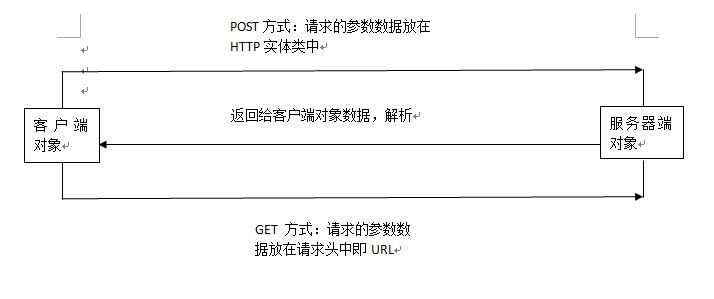
- Android提高之MediaPlayer播放网络视频的实现方法
- Android PopupWindow使用实例
- Android中通知Notification的使用方法
- Android编程布局控件之AbsoluteLayout用法实例分析
- Android拍照裁剪图片
- android 捕获系统异常并上传日志具体实现
- Android App界面的ListView布局实战演练
- Android中贝塞尔曲线的绘制方法示例代码
- Android中使用七牛云存储进行图片上传下载的实例代码
- android编程实现sd卡读取数据库的方法
- Android中的全局变量与局部变量使用小结
- android创建手势识别示例代码
- Android实现悬浮对话框代码
- Android开发之实现GridView支付宝九宫格
- Android编程实现左右滑动切换背景的方法
- Android仿微信顶/底部菜单栏效果
- android开发教程之间隔执行程序(android计时器)
- java实现静默安装apk
- Android实现仿网易新闻的顶部导航指示器
- Android布局技巧之创建可重用的UI组件
- Android自定义控件之组合控件学习笔记分享
- 从源码剖析Android中的Intent组件
- Android开发笔记 TableLayout常用的属性介绍
- Android 自定义Dialog 实例
- Android编程之截屏实现方法(包括scrollview与listview)
- Android ADB详细介绍及用法
- Android中监听软键盘显示状态实现代码
- Andriod开发中引入jar包的正确方式介绍
- Android解析JSON数据的方法分析
- android耳机左右声道接反具体修正方法
Android客户端post请求服务器端实例
作者:佚名 Android开发编辑:admin 更新时间:2022-07-23
Android客户端请求服务器端的详细解释
1. Android客户端与服务器端通信方式:
Android与服务器通信通常采用HTTP通信方式和Socket通信方式,而HTTP通信方式又分get和post两种方式。
2. 解析服务器端返回数据的解释:
(1).对于服务器端来说,返回给客户端的数据格式一般分为html、xml和json这三种格式。
(2). JSON(Javascript Object Notation)是一种轻量级的数据交换格式,相比于xml这种数据交换格式来说,因为解析xml比较的复杂,而且需要编写大段的代码,所以客户端和服务器的数据交换格式往往通过JSON来进行交换。
3. Android中,用GET和POST访问http资源
(1).客户端向服务器端发送请求的时候,向服务器端传送了一个数据块,也就是请求信息。
(2). GET和POST区别:
A: GET请求请提交的数据放置在HTTP请求协议头(也就是url)中,而POST提交的数据则放在实体数据中,安全性比较高。
B: GET方式提交的数据最多只能有1024字节,而POST则没有此限制。

注意:考虑到POST的优势,在Android开发中自己认为最好用POST的请求方式,所以下面自己写了一个小的POST请求的例子。代码如下:
package com.scd.jsondemo.util;
import java.io.IOException;
import java.io.UnsupportedEncodingException;
import java.util.ArrayList;
import java.util.List;
import org.apache.http.HttpEntity;
import org.apache.http.HttpResponse;
import org.apache.http.NameValuePair;
import org.apache.http.client.ClientProtocolException;
import org.apache.http.client.HttpClient;
import org.apache.http.client.entity.UrlEncodedFormEntity;
import org.apache.http.client.methods.HttpPost;
import org.apache.http.impl.client.DefaultHttpClient;
import org.apache.http.message.BasicNameValuePair;
import org.apache.http.protocol.HTTP;
import org.apache.http.util.EntityUtils;
import org.json.JSONException;
import org.json.JSONObject;
public class JsonUtil {
/** 地址 */
private static final String INNER_URL = "http://localhost:8080/index2.jsp";
/** TAG */
private final String TAG = getClass().getSimpleName();
private static final int USER_ID = 1;
/***
* 客户端调用的方法:传递参数向服务器中发送请求
*
* @param userId
* @param userName
* @return
*/
public static JSONObject getData(String userId, String userName) {
int modelId = USER_ID;
List<NameValuePair> list = new ArrayList<NameValuePair>();
list.add(new BasicNameValuePair("userId", userId));
list.add(new BasicNameValuePair("userName", userName));
return doPost(modelId, list);
}
/**
* 请求服务器的方法
*
* @param model
* @param paramList
* @return
*/
private static JSONObject doPost(int model, List<NameValuePair> paramList) {
// 1.创建请求对象
HttpPost httpPost = new HttpPost(INNER_URL);
// post请求方式数据放在实体类中
HttpEntity entity = null;
try {
entity = new UrlEncodedFormEntity(paramList, HTTP.UTF_8);
httpPost.setEntity(entity);
} catch (UnsupportedEncodingException e1) {
e1.printStackTrace();
}
// 2.创建客户端对象
HttpClient httpClient = new DefaultHttpClient();
// 3.客户端带着请求对象请求服务器端
try {
// 服务器端返回请求的数据
HttpResponse httpResponse = httpClient.execute(httpPost);
// 解析请求返回的数据
if (httpResponse != null
&& httpResponse.getStatusLine().getStatusCode() == 200) {
String element = EntityUtils.toString(httpResponse.getEntity(),
HTTP.UTF_8);
if (element.startsWith("{")) {
try {
return new JSONObject(element);
} catch (JSONException e) {
e.printStackTrace();
}
}
}
} catch (ClientProtocolException e) {
e.printStackTrace();
} catch (IOException e) {
e.printStackTrace();
}
return null;
}
}
- 上一篇文章: Android开发中的MVC设计模式浅析
- 下一篇文章: Android中子线程和UI线程通信详解
- Android中如何获取视频文件的截图、缩略图
- Android Studio项目中导入开源库的方法
- Android仿美团分类下拉菜单实例代码
- Android编程根据系列图片绘制动画实例总结
- Android编程实现3D旋转效果实例
- Android使用socket创建简单TCP连接的方法
- Android判断是否为飞行模式简单方法